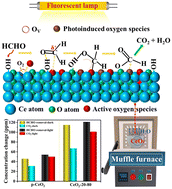Water pretreatment promoting the removal of indoor formaldehyde over nano-CeO2 at ambient temperature†
Abstract
An efficient and noble-metal-free catalyst is of practicality for the ambient temperature removal of indoor formaldehyde (HCHO), which severely threats human health. In this study, a commonly used nano-CeO2 material is improved via a simple water pretreatment for efficient HCHO removal at ambient temperature. Notably, CeO2 pretreated with 20 mL of deionized water at 80 °C (CeO2-20–80) shows a HCHO removal efficiency of 77.3% and HCHO conversion efficiency of 44.9% in 3 h, which is much higher than CeO2 (p-CeO2) without water pretreatment. Indoor fluorescent light further boosts the conversion of HCHO into CO2 with a HCHO removal efficiency of 80.0% and HCHO conversion efficiency of 67.7%. Various characterizations, including XRD, Raman spectroscopy, N2 sorption isotherm, XPS, EPR and theoretical calculations, reveal that the preferential adsorption of H2O molecule on the (220) crystal facet of CeO2, high specific surface area, a large amount of reactive oxygen species and easier adsorption of the HCHO on the (111) crystal facet than (220) of CeO2 are responsible for the enhanced HCHO removal performance of CeO2-20–80. This study provides insight into the improvement of cost-effective catalysts using a simple way and the full utilization of energies on hand for pollution control.



 Please wait while we load your content...
Please wait while we load your content...